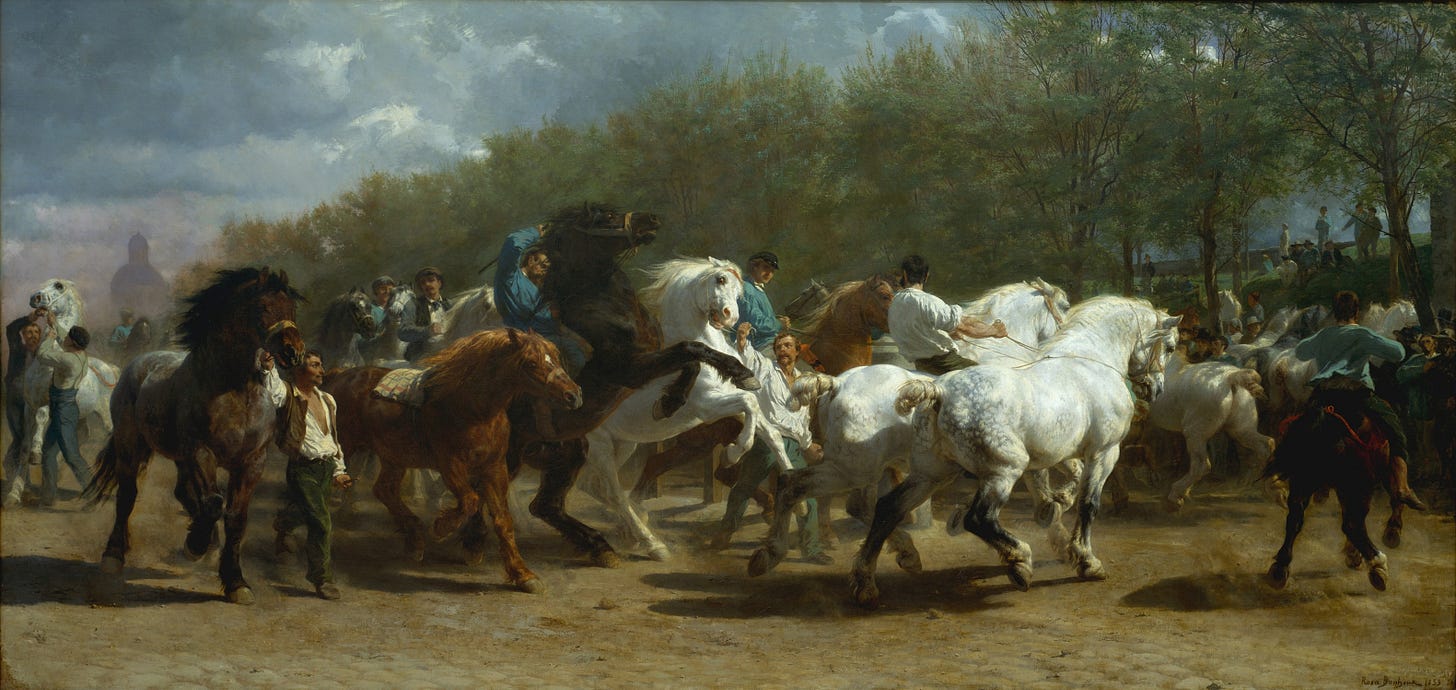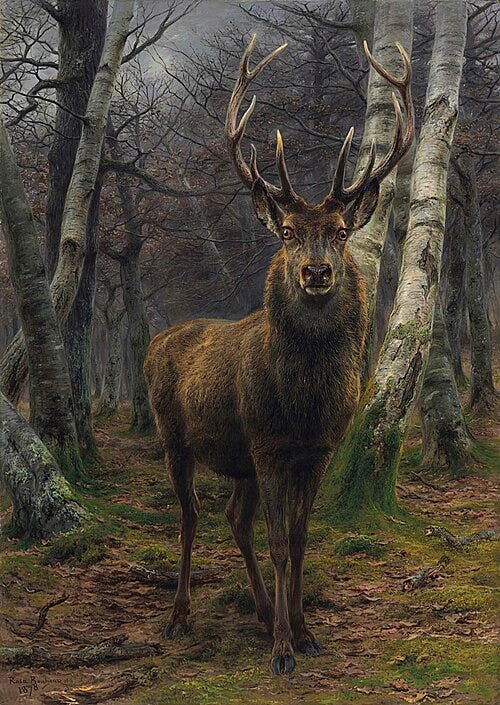
Rosa Bonheur (1822–1899) is celebrated not only for her meticulous and dynamic portrayals of animals but also for her groundbreaking role as a woman in a male‑dominated art world. Her innovative approach to Realism and her defiant personal choices redefined what it meant to be both an artist and an independent individual in nineteenth‑century France.
Born Marie‑Rosalie Bonheur on March 16, 1822, in Bordeaux, France, Rosa was the eldest of four children in a family where art and progressive thought were intertwined. Her father, Oscar‑Raymond Bonheur, was a painter and an ardent member of the Saint‑Simonian movement; a reformist group that championed gender and social equality. This politically charged environment instilled in Rosa a spirit of defiance and self‑reliance at an early age (Britannica).
Denied entry into formal art institutions like the École des Beaux‑Arts because of her gender, Bonheur received her initial training in her father’s workshop. Under his tutelage, she learned traditional techniques through copying engravings, plaster casts, and the works of Dutch and Flemish masters at the Louvre. Her father’s insistence on drawing directly from nature led her to frequent rural settings, livestock markets, and even the Parisian slaughterhouses; environments that later became the backbone of her detailed animal studies. As Hall W. Rockefeller notes on ThoughtCo, this rigorous education provided her with a “profound understanding of animal anatomy and movement” (Rockefeller).

Her formative years were also marked by personal loss; the death of her mother in 1833 left an indelible mark on her psyche. Despite the financial hardships and frequent relocations in Paris, these early experiences honed her observational skills and laid the groundwork for her future career. By the time she first exhibited at the Paris Salon at age 19, Bonheur had already developed a distinctive, naturalistic style that set her apart from her contemporaries (Wikipedia).

Bonheur’s work is a cornerstone of the Realist movement, which sought to depict life as it truly was, eschewing the idealization characteristic of Romanticism. Her technique combined rigorous scientific study with artistic intuition. In paintings such as Ploughing in the Nivernais (1849), she used a palette of earthy tones and layered brushstrokes to create textured, lifelike depictions of oxen and rustic labor. The Metropolitan Museum of Art describes the work as a “visual document of rural toil” that balances dramatic contrasts of light and shadow to emphasize the physicality of the scene ("Ploughing in the Nivernais").

Her magnum opus, The Horse Fair (1852–55), exemplifies her ability to transform an everyday subject into a grand spectacle. By employing sweeping diagonals, a dynamic sense of movement, and meticulous rendering of anatomical details, Bonheur captured not only the muscular power of the horses but also the frenetic energy of the bustling market. The painting’s scale, measuring over 8 feet tall by 16 feet wide, was unprecedented for a female artist and attested to her ambition and technical mastery. According to The Metropolitan Museum of Art, The Horse Fair “imbues a sense of rhythmic intensity that is emblematic of Bonheur’s Realist approach” ("The Horse Fair").
Scholars such as Dore Ashton and Denise Browne Hare, in their book Rosa Bonheur: A Life and a Legend, argue that her scientific approach to studying animal motion, often involving dissections and extensive field sketches, allowed her to render her subjects with astonishing accuracy and vitality. This careful blending of observational rigor with painterly expression set a new standard within the Realist tradition (Ashton and Hare).

At a time when women were expected to adhere to strict domestic roles, Bonheur’s life and art were profoundly radical. She frequently donned men’s clothing, a practical necessity for working in environments deemed “masculine,” such as animal markets and slaughterhouses, and even obtained official permission from the police to cross‑dress. This act of defiance was not merely a matter of convenience; it was a deliberate statement of independence. As she famously stated, “To [my father’s] doctrines I owe my great and glorious ambition for the sex to which I proudly belong and whose independence I shall defend until my dying day” (Rockefeller).
Her personal relationships further underscore her unconventional path. Bonheur maintained a lifelong companionship with Nathalie Micas, whom she met as a teenager, and after Micas’ death, she formed a deep bond with American painter Anna Klumpke. Modern institutions like National Museums Liverpool describe her as “a pioneering figure in feminist art history” whose choices in both her art and lifestyle challenged the era’s gender constraints ("Rosa Bonheur – The Life of a Trailblazer"). While contemporary labels such as “lesbian” or “queer” are anachronistic, many scholars argue that her defiance of traditional gender roles and her intimate partnerships position her as an early icon of gender liberation (Fine).
Bonheur’s insistence on artistic and personal autonomy not only advanced her career but also served as an inspiration for later generations of women artists. Elsa Honig Fine’s Women and Art: A History of Women Painters and Sculptors from the Renaissance to the 20th Century highlights how Bonheur’s success undermined prevailing notions of female inferiority in the arts, thus paving the way for future female pioneers (Fine).

During her lifetime, Rosa Bonheur achieved a level of international fame that few women artists of her era ever realized. Her works were widely exhibited in the Paris Salon and gained particular popularity in England and the United States. The Horse Fair was lauded by critics and admired by figures such as Queen Victoria, while collectors like Cornelius Vanderbilt purchased her works—Vanderbilt later donating The Horse Fair to The Metropolitan Museum of Art ("The Horse Fair").
Her art was reproduced extensively as engravings and prints, which helped disseminate her reputation far beyond the confines of French art circles. Rehs Galleries and institutions such as the National Gallery in London continue to feature her work as a pivotal example of Realism (Rehs Galleries). Moreover, her technical achievements and independent lifestyle have become subjects of renewed scholarly interest, evidenced by recent exhibitions at the Musée d’Orsay and the Dahesh Museum, which aim to restore her status as a central figure in art history.
Bonheur’s legacy endures not only through her paintings but also through the cultural narratives she helped reshape. Her ability to capture the natural world with scientific precision and artistic passion remains influential. As contemporary critics note, her work continues to serve as a touchstone for the principles of Realism and as an enduring reminder of the power of independent, visionary art (DailyArt Magazine).
Rosa Bonheur’s legacy as a Realist painter and feminist pioneer is multifaceted and enduring. Through her painstaking observation of animal life and her fearless challenge to societal norms, she transformed ordinary scenes into monumental works of art that continue to inspire admiration and critical inquiry. Her achievements in both technique and personal independence not only redefined Realist art but also opened the doors for future generations of women to claim their rightful place in the art world. Today, as museums and scholars work to revive her legacy, Bonheur remains a vital figure whose life and work illuminate the intersection of art, science, and social progress.
References:
Ashton, Dore, and Denise Browne Hare. Rosa Bonheur: A Life and a Legend. Viking Press, 1981.
Fine, Elsa Honig. Women and Art: A History of Women Painters and Sculptors from the Renaissance to the 20th Century. Allanheld & Schram, 1978
Rosa Bonheur. Britannica, Encyclopædia Britannica, https://www.britannica.com/biography/Rosa-Bonheur.
Rosa Bonheur. Wikipedia, Wikimedia Foundation, 2025, https://en.wikipedia.org/wiki/Rosa_Bonheur.
Ploughing in the Nivernais. The Metropolitan Museum of Art, https://www.metmuseum.org/art/collection/search/435702.
"The Horse Fair." The Metropolitan Museum of Art, https://www.metmuseum.org/art/collection/search/435702.
Rosa Bonheur – The Life of a Trailblazer. National Museums Liverpool, https://www.liverpoolmuseums.org.uk/stories/life-of-rosa-bonheur.
Rosa Bonheur. Rehs Galleries, https://rehs.com/eng/bio/rosa-bonheur/.




Thanks for this wonderful review, Rogue! I absolutely adore the painting with the lions and cubs, I had never seen it before, it's really impressive. We have this one at Prado Museum. It's a very strange painting that nobody liked some decades ago but now everyone loves. I guess some things have their timing, and now it's the time when it gains momentum. It's a bit tacky too, like the cover of a heavy metal album, hahaha, but I love it so much!
https://www.museodelprado.es/en/the-collection/art-work/el-cid/19984271-9cb6-476d-8655-f012e1fec1bf